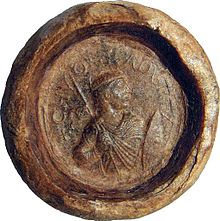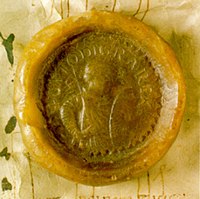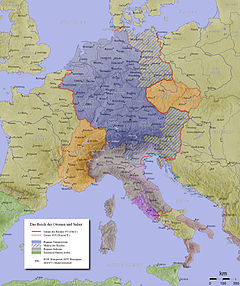Eastern Franconia

As eastern kingdom (Latin regnum francorum orientalium ) refers to the from the division of the Frankish Empire in 843 emerged eastern part of empire. It is the early medieval forerunner of the Holy Roman Empire .
story
With the Treaty of Verdun in 843, the sons of Louis I the Pious († 840) Lothar I , Charles II the Bald and Ludwig II the German ended the struggle for power and shared power. Lothar received the middle , Karl the western and Ludwig the eastern part of the empire. After the death of the last East Franconian Carolingian , the election of Konrad as king in 911 was an important step on the way to an independent empire. This development came to an end in 962 with the coronation of Otto I as emperor , which is seen as the beginning of the Holy Roman Empire.
Fall of the Franconian Empire
The division of 843 was merely a division of rule . It corresponded to Frankish customs and did not mean the end of a common Frankish empire. Ludwig I tried to secure the unity of the empire by means of an inheritance regulation at the Aachen Reichstag in 817 , but thwarted this again in 829 when he made a new regulation in favor of his son from his second marriage, Karl. This triggered a power struggle that was only ended with the unification of Verdun. Since there was no longer any permanent unification of the empire under one ruler, the east and west diverged. This was largely due to the fact that the naturally occurring power struggles among the Carolingians led to a neglect of the fight against external enemies. The devastation wrought by the Normans , Saracens and, from 899, the Hungarians in the imperial territory led to a loss of reputation for the Carolingian dynasty and favored the rise of local leaders.
East Franconian Carolingians
The area that fell to Ludwig the German was smaller and less developed than the western parts. It meant a certain compensation that Ludwig still had the unrestricted right to appoint a bishop. He made the king palaces in Regensburg and Frankfurt with the establishment of Palatinate chapels to centers of his kingdom and sought through marriage policy at both the East Frankish nobility of his dynasty to bind and to anchor his family in various tribal areas. For the time being, further proselytizing the Slavs , i.e. continuing the expansion to the east , was out of the question. Neither the mass baptism of Bohemian nobles in 845 nor the appointment of the Christian Rastislav in 846 by Ludwig in Moravia helped to further secure the nominal suzerainty of the Carolingians. The division of the Middle Kingdom after Lothar's death in 855 led to disputes with Charles the Bald about the division of the middle areas and the question of which family branch should receive the imperial dignity . In 870 the later Lorraine was divided in the Treaty of Meersen , but in 880 it fell entirely to the Eastern Empire in the Treaty of Ribemont . After the death of Lothar's son Ludwig II , emperor since 855, Charles the Bald († 877) found the support of Pope John VIII and was crowned emperor in 875. During the following fighting, Ludwig the German died in 876.
According to his arrangement, the eastern empire was under his sons Karlmann († 880), Ludwig III. the younger († 882) and Charles III. divided the fat . After the death of his brothers and the death of the two sons of the West Franconian King Ludwig the Stammler , Ludwig III. († 882) and Karlmann († 884), Charlemagne († 888) was able to reunite the empire of Charlemagne for a short time from 885 . While Charles pursued his ambitions, the Norman incursions had intensified and the West had been badly affected. The focus of power had thus shifted to the east and the West Franconian nobles offered Karl the Fat the western crown. Karl, suffering from epilepsy, was unable to protect the vast empire and twice allowed almost defeated Normans to retreat in return for tribute. His loss of reputation was so severe that Karlmann's illegitimate son Arnulf von Kärnten was able to depose him shortly before his death. The reunification under one ruler remained an episode.
The Carolingians had lost so much of their authority that in the west the non-Carolingian Odo of Paris was made king thanks to his resistance to the Normans. Nevertheless, he and his adversary Charles the Simple , a grandson of Charles the Bald, tried to legitimize their rule through Arnulf. A clear sign of the supremacy that the East Frankish king now exercised and led to the imperial coronation in 896. His stroke on the way back from Italy may have prevented him from pursuing further ambitions. After Arnulf's death in 899, his seven-year-old son Ludwig IV was elected king in eastern France in 900 . His "rule", or rather that of, among others, Archbishop Hatto of Mainz , was under the newly emerging danger of the Hungarians under Árpád , who had already invaded Italy in 899 and after two important victories in 906 and 910 devastated Eastern Franconia almost annually. Ludwig IV died in 911.
The election of Konrad and the establishment of the duchies
Although the older tribal duchies had been dissolved since Charlemagne, the inhabitants of the East Franconian Empire still lived according to different tribal rights, depending on their tribal origin. When Ludwig the German installed his sons as partial kings in the old tribal areas, the differentiation according to tribal borders was further promoted in the Eastern Empire. The endless fratricidal struggles and the incursions of external enemies that it encouraged, and in particular the reign of the clergy and nobles in the East Frankish empire in the name of Louis the Child, led to a further loss of reputation for the Carolingian dynasty. In the defense against external enemies, the position of powerful local nobles was strengthened. Often they led the actual fight against Normans and Hungarians as leaders of their tribal association and thereby gained reputation. As a result, the most powerful nobles of the border areas in Saxony and Bavaria achieved a superior position as dukes relatively early. From around the year 900, powerful nobles in Swabia and Franconia tried to achieve a ducal position. When Ludwig died in 911, there were already three established tribal dukes in Saxony, Franconia and Bavaria, who preferred one from their midst to another Carolingian, and who chose the Franconian and non-Carolingian Konrad I as the new joint East Franconian king, since each duke himself alone Felt no match for enemies. On this occasion, however, Lorraine joined the Western Empire. The external threat developed a certain sense of togetherness, from which an independent empire was formed, which included the (so-called younger) tribal duchies of Franconia , Saxony , Bavaria , Swabia and, since 925, Lorraine .
Conrad I failed, however, when he tried, based on the church, to enforce his rule against the dukes. After unsuccessful attempts to recapture Lorraine, its reputation was considerably weakened when the Bavarian Duke Arnulf and the Swabian Erchanger went into battle against the Hungarians in 913 , while the king remained inactive. Attempts to enforce his rule against them and the powerful Duke Heinrich of Saxony failed. Shortly before his death in 918, Konrad persuaded his brother Eberhard to renounce his successor and to support Heinrich. According to the reading of the later chroniclers , this was done from the insight that he lacked the salvation of the king .
Heinrich I.
Henry, elected king by Saxony and Franconia in 919, proceeded more cautiously. With the Dukes Arnulf of Bavaria and Burchard of Swabia, he reached an agreement without a fight until 920. They recognized his rule and retained the important right of disposal over the church. This gave Heinrich the opportunity to take advantage of further power struggles in western France by conquering Lorraine in 925. An invasion of the Hungarians in 926 was fortunate enough when he succeeded in capturing a Hungarian prince and achieving a nine-year armistice. At the Worms Reichstag in 926, important foundations for his reign were set. The now deceased Duke Burchard was replaced by a man of Heinrich who, as the penultimate duke, left canon law to him. A castle order was issued, the army reorganized and his reputation increased by the attendance of Rudolf of Burgundy , who possibly gave him an important relic on this occasion, the Holy Lance , which later played an important role in the appreciation of Otto I's victories. As a result, Heinrich pacified the Slavs in several campaigns, achieved a significant victory against the Hungarians in the battle of Riyadh in 933 , another against the Normans in the north and in 935 the recognition of his rule over Lorraine by the West Frankish king. Shortly before his death in 936 he had the dukes confirm the succession of his son.
Otto I.
Otto I's election in Aachen was carefully staged in order to underline the Saxon dynasty's claim to power and to establish a reference to Charlemagne's universal claim to power . But this first had to be enforced. After a Slav uprising, Otto faced rebellions from his brothers Thankmar and Heinrich , who were not satisfied with the compensation of property as a replacement for part of the rule according to Frankish custom. In addition, Otto had to devote himself to an insubordinate young Duke of Bavaria who did not want to give him the important canon law. In 939 Otto emerged victorious from this turmoil. The result was the unrestricted succession right of the eldest son and the reorganization of the duchies. Saxony and Franconia remained directly in the hands of the king, while in Lorraine Heinrich, who was again accepted by grace, was installed. The dukes of Bavaria and Swabia were connected to the dynasty by marriage. Otto later consistently pursued this policy and tried whenever possible to expand the influence of his house on the duchies.
When Berengar was striving for royal dignity in Italy in 950, Otto saw the time had come to expand his influence south. After careful preparation, Otto moved to Italy, took over the Lombard royal dignity and married Adelheid , the widow of the former King of Italy. Before he could continue to strive for the emperor, however, an uprising by his son Liudolf forced him to repent, who feared for his succession to the throne. In 954 the Hungarians used the internal conflict to attack again and besieged Augsburg. The outside enemy used Otto, who was able to settle all disputes, and in 955 with a large army, under the sign of victory of the Holy Lance , which defeated Hungary on the Lechfeld near Augsburg. This victory greatly increased Otto's reputation far beyond the borders of his empire. The expected grab for the imperial dignity followed when Berengar, regained in Italy, prepared for the attack on Rome and Pope Otto called for help (960). After careful preparations, the second Italian campaign began in 961, which culminated in the coronation as emperor on February 2, 962.
In a third move to Italy from 966 to 972, Otto rounded off his power with the foundation of the Archdiocese of Magdeburg , approved by the Pope , which supported the expansion to the east that had already been achieved through the appointment of margraves and the establishment of dioceses. Another result, after lengthy disputes with the Byzantine Empire in southern Italy, was the marriage of his son Otto to Theophanu , a Byzantine princess. Otto also sought to support his power by including clergy trained in his chapels in the administration of the empire. When Otto died in 973 shortly after the Quedlinburg Assembly, in which embassies from all over Europe documented the splendor of his house, the hegemonic position of the new Holy Roman Empire in Europe was established.
Kings of Eastern Franconia
- Ludwig II (the German), (805 / 809–876), king in Bavaria since 817 and in Eastern France since 843 (with the Treaty of Verdun)
- in part:
- Karlmann , (around 830–880), 876–880 king in Bavaria, 877–879 also king of Italy
- Ludwig III. , the younger , (835–882), King 876–882 in Franconia, Saxony and Thuringia, since 880 also in Bavaria
- Charles III (839-888), King in Alemannia from 876, also King of Italy since 879, King of the whole of Eastern Franconia from 882 (also Roman Emperor since 881)
- Arnulf of Carinthia (850–899), king since 887, Roman emperor since 896
- Ludwig IV. (893–911), king from 900 to 911
- Konrad I (881–918), king from 911 to 918
- Heinrich I (875 / 876–936), king from 919 to 936
- Otto I (“the great”, 912–973), East Franconian king since 936, Roman-German emperor since 962
literature
- Andreas Bihrer : Encounters between the East Franconian-German Empire and England (850–1100). Contacts - constellations - functionalizations - effects . Ostfildern 2012, ISBN 978-3-7995-4290-6 .
- Carlrichard Brühl : The birth of two peoples. Germans and French (9th-11th centuries) . Böhlau Verlag, Cologne et al. 2001.
- Roman Deutinger : Royal rule in the East Franconian Empire. A pragmatic constitutional history of the late Carolingian era. Ostfildern 2006, ISBN 3-7995-5720-2 . ( Review )
- Ernst Dümmler : History of the East Franconian Empire. First volume. Ludwig the German until the Peace of Koblenz 860 . Wissenschaftliche Buchgesellschaft, Darmstadt 1960 (reprint of the 2nd edition from 1887; old, but basic illustration).
- Ernst Dümmler: History of the East Franconian Empire. Second volume. Ludwig the German from the Peace of Koblenz until his death (860–876) . Wissenschaftliche Buchgesellschaft, Darmstadt 1960 (reprint of the 2nd edition from 1887; old but basic illustration).
- Johannes Fried : The way into history. The origins of Germany up to 1024 (Propylaea History of Germany 1) . Berlin 1994, ISBN 3-549-05811-X .


